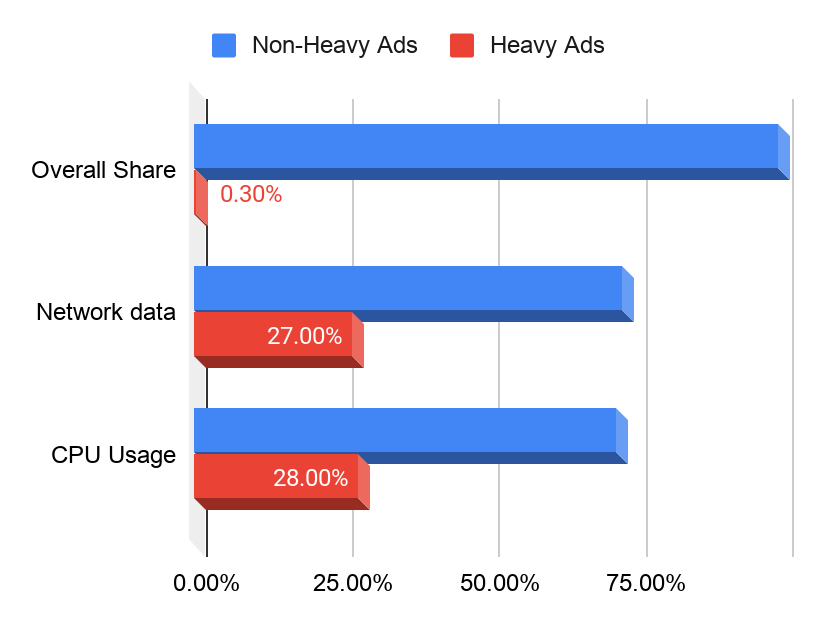Google announced that it will start blocking resource-heavy ads from its Chrome browser starting from late August 2020.
According to Marshall Vale, Product Manager, Chrome, they have recently found out that some of the heavy ads are responsible to put a lot of strain on the users’ battery or their home network data, without them ever knowing about it until it is too late and the damage has already been done!
Most of these ads mine cryptocurrency are improperly programmed, thus resulted as increased usage on the network. This is the reason why they can put so much strain on the battery life, draining it to no bounds. On the other hand, or maybe simultaneously, they strain already heavily saturated networks, which the user only gets to know about once they receive huge bills from the network provider companies!
There is a criterion by which Google’s Chrome will block ads. If an ad uses the thresholds of 4MB of network data, 15 seconds of CPU usage in any 30 seconds, or 60 seconds of total CPU usage, it will be blocked right away.
As per Google, only 0.3% of ads surpass these thresholds, and they account for up to 27% of network data used by ads and up to 28% of all ad CPU usage.

When Chrome will block such ads, it will show an error page in the place or frame where these ads were supposed to be shown.
In Chrome 80 that was rolled out by Google recently, there is an option of Heavy Ad Intervention. This feature basically unloads those ads that use heavy resources like CPU, battery, GPU, memory, and bandwidth.
This feature can be Enabled by opening a new tab and pasting “chrome://flags/#enable-heavy-ad-intervention” in the address bar.
By retaining this feature and further amplifying the notion of blocking such ads in the Chrome browser, Google has made an effort to show to its users that it cares for them. These ads have always been a hassle in one way or the other, and it is nice to know that finally there is a hope to get them blocked.
Google has been doing a lot of other things to make its users happy too of lately. Some tweaks here, some minor changes there. Recently it has been playing around with Chrome’s Dark Mode, and favicons, while dealing with corrupt Chrome extensions or releasing Vital Tool to let the users check the vitality of their Chrome browser. And many more!
It seems that every week, there is one good news after another from Google, and it is quite relieving especially in such crucial times of the coronavirus pandemic when the entire world is already going through so much.
These efforts by Google are commendable and much appreciated.
Read next: Google Chrome Is Working On Media Feeds Feature That Will Allow Websites To Suggest Videos In The Browser
According to Marshall Vale, Product Manager, Chrome, they have recently found out that some of the heavy ads are responsible to put a lot of strain on the users’ battery or their home network data, without them ever knowing about it until it is too late and the damage has already been done!
Most of these ads mine cryptocurrency are improperly programmed, thus resulted as increased usage on the network. This is the reason why they can put so much strain on the battery life, draining it to no bounds. On the other hand, or maybe simultaneously, they strain already heavily saturated networks, which the user only gets to know about once they receive huge bills from the network provider companies!
There is a criterion by which Google’s Chrome will block ads. If an ad uses the thresholds of 4MB of network data, 15 seconds of CPU usage in any 30 seconds, or 60 seconds of total CPU usage, it will be blocked right away.
As per Google, only 0.3% of ads surpass these thresholds, and they account for up to 27% of network data used by ads and up to 28% of all ad CPU usage.

When Chrome will block such ads, it will show an error page in the place or frame where these ads were supposed to be shown.
In Chrome 80 that was rolled out by Google recently, there is an option of Heavy Ad Intervention. This feature basically unloads those ads that use heavy resources like CPU, battery, GPU, memory, and bandwidth.
This feature can be Enabled by opening a new tab and pasting “chrome://flags/#enable-heavy-ad-intervention” in the address bar.
By retaining this feature and further amplifying the notion of blocking such ads in the Chrome browser, Google has made an effort to show to its users that it cares for them. These ads have always been a hassle in one way or the other, and it is nice to know that finally there is a hope to get them blocked.
- Also read: Google brings on a tab-grouping feature for its Chrome browser and it is as good as it sounds
Google has been doing a lot of other things to make its users happy too of lately. Some tweaks here, some minor changes there. Recently it has been playing around with Chrome’s Dark Mode, and favicons, while dealing with corrupt Chrome extensions or releasing Vital Tool to let the users check the vitality of their Chrome browser. And many more!
It seems that every week, there is one good news after another from Google, and it is quite relieving especially in such crucial times of the coronavirus pandemic when the entire world is already going through so much.
These efforts by Google are commendable and much appreciated.
Read next: Google Chrome Is Working On Media Feeds Feature That Will Allow Websites To Suggest Videos In The Browser

